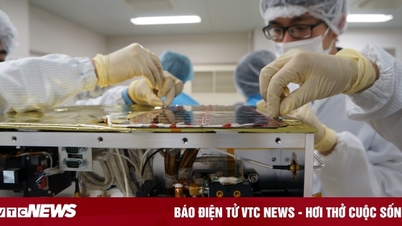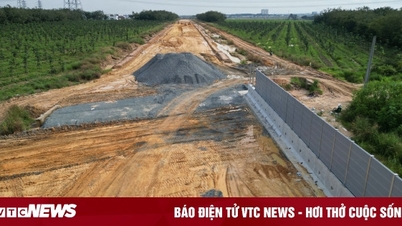China's "factory in orbit" is taking shape after a technological breakthrough with an inflatable and reconfigurable space module.
This turning point marks China's entry into the race with the US and many other countries in building large-scale industrial production lines in outer space.

Parts of the smart transforming frame can be folded during launch and inflated and unfolded while in orbit. (Source: Handout)
According to the developers, this smart frame structure is designed to fold up when launched and self-inflate and expand when in orbit.
This structure helps create a large and stable operating space. Each module is a “building block” for the outer space factory.
“Space factories” are becoming a new frontier attracting investment from both the public and private sectors. In 2023, the US startup Varda Space Industries announced the successful launch of the W-Series 1 satellite, which they called “ the world’s first space factory”.
Yang Yiqiang, director of the Aerospace Science and Technology Center of the Institute of Mechanics (Chinese Academy of Sciences – CAS), said that this technology will move China's space manufacturing sector from the "proof of concept" stage to "technical realization".
“We will likely be able to directly manufacture and manufacture in the space environment, moving towards independent development and exploitation of extraterrestrial resources,” he said.

The platform could be used to produce biopharmaceuticals, 3D-printed products and new materials in a space factory, according to the Chinese Academy of Mechanics. (Source: Handout)
According to the announcement of the Institute of Mechanics on November 3, the research team tested the key module of the "space factory" with many domestic research agencies.
Ground testing results showed the module performed as expected or exceeded its performance requirements. The team also obtained key parameters such as the critical pressure and the amount of gas required for full deployment through simulated vacuum testing in Shenyang, northeastern China.
This success is a major step towards space manufacturing, helping to overcome limitations on the size of rocket payload bays and reduce the cost of building large orbital objects.
According to CAS, this scalable structure will be an ideal platform for mass production of products such as biopharmaceuticals, new materials or 3D printed products in the future.
Countries are now competing fiercely to exploit the potential of space development, with the aim of gaining an advantage in the future space economy .
“Whichever country masters the 'production' capacity in space will take the initiative in developing the space economy in the future,” CAS commented.
However, traditional orbital platforms are currently difficult to undertake large-scale multi-functional manufacturing tasks due to limitations in rocket size, high construction costs, and difficulty in expanding in space.
To overcome this, the Chinese research team developed a reconfigurable inflatable module made from a super-flexible composite material with a steel frame and advanced fiber layers.
The CAS Institute of Mechanics said that when completed, the platform will open up new opportunities in the field of space biomedicine, research on special materials as well as maintenance of equipment in orbit.
On-orbit manufacturing is important because it allows for the creation of unique materials and products that are not possible on Earth, while removing design and launch scale limitations.
Source: https://vtcnews.vn/trung-quoc-phat-trien-nha-may-tren-quy-dao-voi-cong-nghe-mod-dun-bom-phong-ar986449.html


![[Photo] Prime Minister Pham Minh Chinh attends a conference to review one year of deploying forces to participate in protecting security and order at the grassroots level.](https://vphoto.vietnam.vn/thumb/1200x675/vietnam/resource/IMAGE/2025/11/12/1762957553775_dsc-2379-jpg.webp)




![[Photo] Highways passing through Dong Nai](https://vphoto.vietnam.vn/thumb/1200x675/vietnam/resource/IMAGE/2025/11/12/1762940149627_ndo_br_1-resize-5756-jpg.webp)


































































































![Dong Nai OCOP transition: [Article 3] Linking tourism with OCOP product consumption](https://vphoto.vietnam.vn/thumb/402x226/vietnam/resource/IMAGE/2025/11/10/1762739199309_1324-2740-7_n-162543_981.jpeg)







Comment (0)